Advertisements
Chapters
2: A Snake Charmer’s Story
3: From Tasting to Digesting
4: Mangoes Round the Year
5: Seeds and Seeds
6: Every Drop Counts
7: Experiments with Water
8: A Treat for Mosquitoes
9: Up You Go!
▶ 10: Walls Tell Stories
11: Sunita in Space
12: What if it Finishes ...?
13: A Shelter so High!
14: When the Earth Shook!
15: Blow Hot, Blow Cold
16: Who will do this Work?
17: Across the Wall
18: No Place for Us?
19: A Seed tells a Farmer’s Story
20: Whose Forests?
21: Like Father, Like Daughter
22: On the Move Again
![NCERT solutions for Environmental Studies - Looking Around [English] Class 5 chapter 10 - Walls Tell Stories NCERT solutions for Environmental Studies - Looking Around [English] Class 5 chapter 10 - Walls Tell Stories - Shaalaa.com](/images/environmental-studies-looking-around-english-class-5_6:71bdf81a5f57474cb6fe25f9506ae503.jpg)
Advertisements
Solutions for Chapter 10: Walls Tell Stories
Below listed, you can find solutions for Chapter 10 of CBSE NCERT for Environmental Studies - Looking Around [English] Class 5.
NCERT solutions for Environmental Studies - Looking Around [English] Class 5 10 Walls Tell Stories Walls Tell Stories [Pages 88 - 98]
Think
Why were bastions made in the fort wall?
Why were big holes made in them?
What difference would be there if you were to look from a straight flat wall or a bastion at a height?
How would the soldiers find peeping from the holes in the bastions useful while attacking?
Think and discuss
How would the fountains have worked?
What arrangements would have been made in the building for air and light?
Look carefully at the picture of the beautiful carving on the wall. What kind of tools would have been used for such fine carving?
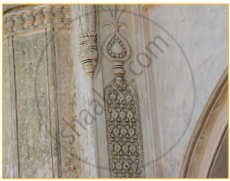
We still do not have any electricty at many places in our country. Even at places which do have electricity, imagine what would happen if there was no electricity for one week. What are the things that would be difficult to manage without it?
Tell and write
Look carefully at the map of Golconda. On the map, arrows show all four directions.
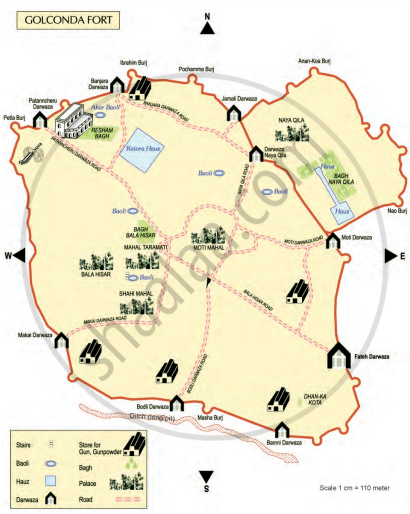
- If you are peeping inside from Bodli Darwaza, in which direction from you is Katora Hauz?
- If someone is entering from Banjara Darwaza, in which direction from her is Katora Hauz?
- In which direction will you walk from Bala Hisar to reach Moti Mahal?
- How many gates can you see on the outer walls of the fort?
- Count how many palaces are there in the fort?
- What arrangements for water can you see inside the fort? For example, wells, tanks, step-wells.
On the map, 1 cm distance is equal to a distance of 110 meters on the ground. Now tell
On the map, the distance between Bala Hisar and Fateh Darwaja is ____ cm. On the ground, the distance between the two would be ____ meters.
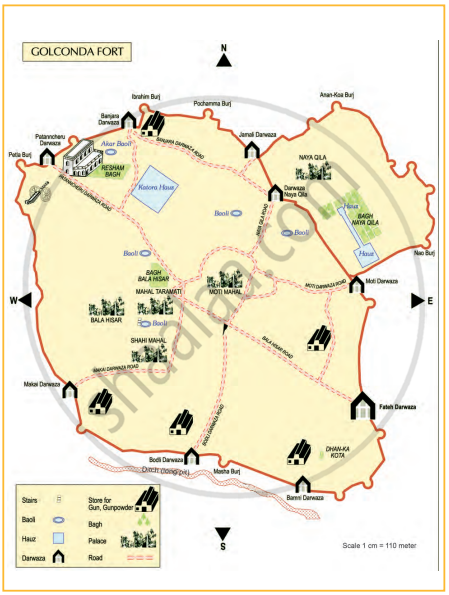
On the map, 1 cm distance is equal to a distance of 110 metres on the ground. Now tell
How far is Makai Darwaza from Fateh Darwaza?

Discuss
Have you recently read or heard about any country attacking or going to war with another country?
Find out what was the reason for this war.
What kind of weapons were used in this war?
What kind of destruction was caused because of this?
Find out
Have you seen anything made of bronze? What?
Tribal people have been using bronze to make many things for thousands of years. One wonders how they took out copper and tin from the deep mines, melted these metals, and turned them into beautiful things!
Find out from your elders about some of the things made from bronze that were, or are still used in your house. From its colour try to identify which one of them is made from copper, which is from brass, and which is from bronze.
Arrangements for water
The picture shown here is made after seeing a very old painting of those times. Can you think why bullocks have been used here?
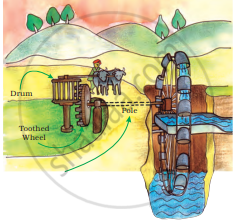
Use your hand movement to show in which direction the drum attached to the rod moves when the bullocks move.

In which direction would the ‘toothed wheel’ move?

Now imagine, how would this garland of pots lift water from the well?
Do you now get some idea about how the tanks could have been filled by lifting water from the wells?
Where else have you seen such wheels attached to each other. For example, in the gear of a cycle or somewhere else?
Look around and find out how water is pumped up from the ground to higher places?
How is water pumped up using electricity? How is water lifted without electricity?
Close your eyes and go back in time!
What is the Sultan doing in the palace? What kind of clothes is he wearing? What dishes are being offered to him? But why does he seem so worried? And in what language is he talking?
Imagine the rooms in the palace - the beautiful carpets and curtains, the fountains on the terrace…and the sweet smell of roses and chameli - where is this coming from?
What are the different kinds of factories you can see? How many people are working there? What are they doing? What are they wearing? How long do you think they work?
Look there! See how finely those craftsmen are carving the stones using a chisel and hammer? Can you see the stone dust in the air. Do you think this stone dust would harm them in some way?
Write
What kinds of pots have you seen around you?
Try to find out from your grandparents about the other kinds of pots and pans they used in their time?
Have you ever been to some museum or heard about it? What all things are there in a museum?
Survey and write
Is there any old building or monument near your house which people come to see? If yes, name it.
Have you ever gone to see an old monument? Which was that? Did you feel it told you a story? What could you know about those times from it?
How old was it? How did you know?
What was it made of?
What colour was it?
Were there any special kinds of designs on the old building? Draw them in your notebook.
Who used to live there in the olden days?
What kinds of activities took place there?
Do some people still live there?
Look at the painting and tell
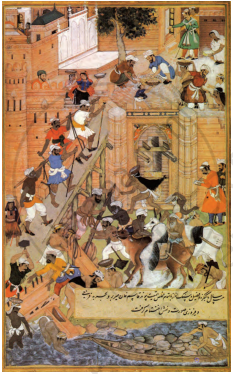
- What kinds of work are people doing?
- How many men and women are working?
- See, how they are taking the huge pillar up along the slope?
- Is it easier to lift a heavy thing straight up or along a slope?
- Were you able to see the man carrying water in a Mashak (leather bag)?
What we have learnt
Sangeeta thinks it is useless to keep old things in a museum. How would you convince her that it is important to have a museum?
Why do you think the chapter is named, ‘Walls Tell Stories’?
Solutions for 10: Walls Tell Stories
![NCERT solutions for Environmental Studies - Looking Around [English] Class 5 chapter 10 - Walls Tell Stories NCERT solutions for Environmental Studies - Looking Around [English] Class 5 chapter 10 - Walls Tell Stories - Shaalaa.com](/images/environmental-studies-looking-around-english-class-5_6:71bdf81a5f57474cb6fe25f9506ae503.jpg)
NCERT solutions for Environmental Studies - Looking Around [English] Class 5 chapter 10 - Walls Tell Stories
Shaalaa.com has the CBSE Mathematics Environmental Studies - Looking Around [English] Class 5 CBSE solutions in a manner that help students grasp basic concepts better and faster. The detailed, step-by-step solutions will help you understand the concepts better and clarify any confusion. NCERT solutions for Mathematics Environmental Studies - Looking Around [English] Class 5 CBSE 10 (Walls Tell Stories) include all questions with answers and detailed explanations. This will clear students' doubts about questions and improve their application skills while preparing for board exams.
Further, we at Shaalaa.com provide such solutions so students can prepare for written exams. NCERT textbook solutions can be a core help for self-study and provide excellent self-help guidance for students.
Concepts covered in Environmental Studies - Looking Around [English] Class 5 chapter 10 Walls Tell Stories are Walls Tell Stories.
Using NCERT Environmental Studies - Looking Around [English] Class 5 solutions Walls Tell Stories exercise by students is an easy way to prepare for the exams, as they involve solutions arranged chapter-wise and also page-wise. The questions involved in NCERT Solutions are essential questions that can be asked in the final exam. Maximum CBSE Environmental Studies - Looking Around [English] Class 5 students prefer NCERT Textbook Solutions to score more in exams.
Get the free view of Chapter 10, Walls Tell Stories Environmental Studies - Looking Around [English] Class 5 additional questions for Mathematics Environmental Studies - Looking Around [English] Class 5 CBSE, and you can use Shaalaa.com to keep it handy for your exam preparation.
